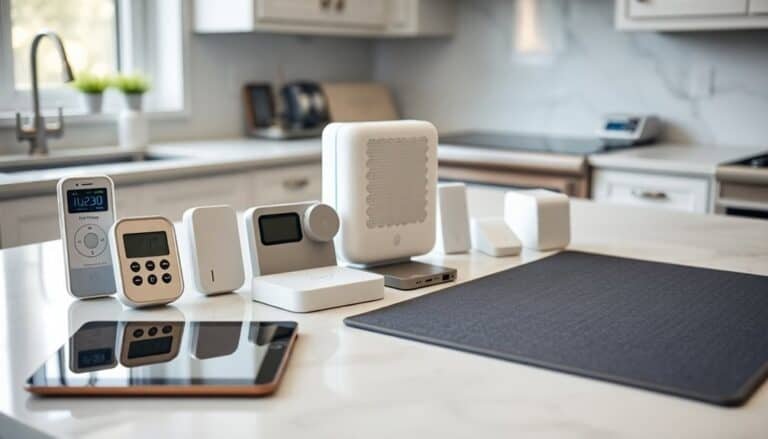EMF Protection on a Budget (Low-Cost Tips)
To budget-protect against EMF, keep devices on desks and use EMF-blocking cases or mats like DefenderShield and SafeSleeve. Create low-EMF zones by positioning beds away from routers and employing shielded wiring.
DIY options include crafting Faraday cages with aluminum foil, offering cost-effective protection. These simple measures enhance safety without high expenses, and more budget-friendly strategies are available for exploration.
Disclaimer: As an affiliate, I may collect a share of sales from the links on this page.
Practical Measures for Reducing EMF Exposure

When it comes to reducing EMF exposure, several practical measures can considerably lower your risk. Distance is key; keep devices, like laptops, on tables rather than your lap. Position wireless modems away from your workspace to minimize direct exposure. Additionally, be aware that natural non-polarized EMFs are essential for biological health, so maintaining some exposure to them is important. Optimizing your workspace layout by placing EMF sources at a safe distance from you and your colleagues can significantly enhance your overall safety. Implement cable management by relocating electrical wires away from your body. Use external keyboards, mice, and monitors to further increase device distance, effectively reducing EMF without significant cost.
Cost-Effective EMF Protection Products
Cost-effective EMF protection products play an essential role in safeguarding individuals from potentially harmful radiation.
Products like DefenderShield utilize Ultra Armor technology, blocking up to 99% of EMF and 5G radiation. EMF protection devices are designed to limit exposure and can vary in effectiveness.
SafeSleeve cases, lab-tested, protect iPhones and Samsung Galaxy devices, blocking over 99% of RF and 92% of ELF radiation.
BON CHARGE offers laptop mats and phone pouches designed to effectively shield against frequencies up to 40GHz.
Lifetune One stickers adhere to devices, providing protection within a 19 ft diameter. LessEMF.com has been a leader in EMF mitigation since 1996, making effective EMF protection accessible to everyone.
These products feature advanced materials for durability, compatibility, and style, making effective EMF protection accessible to everyone.
Smart Home Layout Strategies

Smart home layout strategies can considerably reduce electromagnetic field (EMF) exposure in your living space.
Begin by placing beds and furniture away from EMF sources, like Wi-Fi routers and electrical outlets. Create low-EMF zones in bedrooms by eliminating electronic devices. Additionally, be aware that common sources of EMF include cell phones and household appliances, which can impact your overall exposure. It is important to assess radiation levels from these devices to determine their impact on your environment.
Use shielded wiring to contain EMF radiation within walls. Arrange your workspace to minimize proximity to devices, ensuring a tech-free area whenever possible.
Choose metal-free and non-conductive furniture materials to decrease EMF amplification.
Finally, consider using wired internet connections instead of Wi-Fi.
DIY EMF Shielding Solutions
Creating an EMF-safe environment doesn’t have to be an expensive endeavor. You can use stainless steel mesh, copper taffeta fabric, or aluminum window screens to block EMF effectively.
For a budget-friendly option, repurpose existing materials, such as aluminum foil. Employ a Faraday cage approach using these conductive materials, or create a bed canopy for sleep protection.
Consider applying Y-Shield paint on walls or using shielding fabric beneath your bed. Regularly assess your EMF levels and combine these projects with strategic device placement.
Simple designs and bulk purchases can enhance your shielding solutions while keeping costs low.
Reducing EMF From External Sources

When it comes to reducing EMF from external sources, awareness and proactive measures play a crucial role.
You can minimize exposure with these tactical approaches:
- Install low-E windows to block external EMFs.
- Use conductive materials in walls for better shielding.
- Choose land away from high-voltage power lines.
- Properly orient buildings to face away from cell towers.
- Regularly monitor EMF levels with an EMF meter.
Budget-Friendly Lifestyle Changes
To effectively reduce your exposure to electromagnetic fields (EMFs), you can adopt several budget-friendly lifestyle changes that are both simple and practical.
Start using EMF-protective cases for devices. Opt for hands-free options, like speakerphone, during calls. Avoid carrying devices in pockets and reduce overall screen time.
Establish device-free zones at home to limit exposure. Consider investing in an affordable EMF meter to identify high-exposure areas.
For additional protection, spend more time outdoors and consider using natural EMF-blocking stones, like Black Tourmaline and Shungite, which are inexpensive yet effective options.
Implementing these changes can greatly lower your EMF exposure.
Frequently Asked Questions
How Do EMFS Affect Animal Health and Safety?
EMFs can impact animal health by inducing neurobehavioral changes, increasing oxidative stress, and disrupting habitats. Species may experience altered behaviors, reproductive issues, and migration challenges, highlighting the importance of understanding these electromagnetic influences on wildlife safety.
Can EMF Exposure Cause Long-Term Health Issues?
Yes, EMF exposure can cause long-term health issues. You might experience oxidative stress, cognitive impairment, or increased cancer risks. It’s crucial to monitor your exposure and consider protective measures to maintain your well-being.
What Are Common Misconceptions About EMF Protection?
You might think all EMF protectors work the same, but that’s a classic myth. Some increase your exposure, while others fail to provide genuine safety. It’s essential to discern fact from fiction for effective protection.
Are There Specific EMF Levels That Are Considered Dangerous?
Yes, specific EMF levels can be dangerous. The ICNIRP sets limits for general public exposure at 100 microteslas (µT). Exceeding these limits, especially in occupational settings, may risk health due to potential adverse effects.
How Can I Measure EMF Exposure in My Home?
To measure EMF exposure in your home, use different EMF meters for various fields. Check appliance manuals, conduct DIY measurements, and scan for external sources to assess your environment effectively and guarantee your safety.
Conclusion
Reduce EMF exposure affordably by rearranging smart devices for optimal distance. Use cost-effective shielding products and DIY solutions with accessible materials. Limit external EMF sources with EMF-blocking curtains and shielding plants. Minor lifestyle changes, such as reducing screen time, also help. These practical steps create a safer home environment, one small measure at a time.


